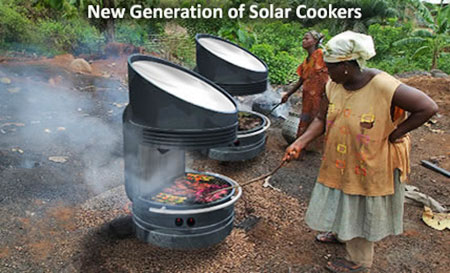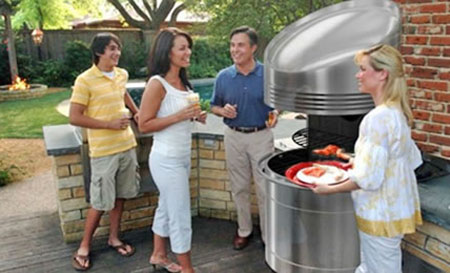|

by Marco Torres
October 12, 2013
from
PreventDisease Website
The newest generation of solar grills
can store heat for longer cooking times and hotter temperatures
while reducing the problem of intermittent sun.
Based on technology developed by MIT
professor David Wilson, the grills generate cooking
temperatures of 450F, and offer up to 25 hours of straight cooking
time without any energy but the sun.

Cooking with a solar grill is probably the greenest method of
preparing your food. It is also one of the most easily accessible
forms of solar power.
A solar grill or oven is a device that harnesses sunlight to create
heat energy. It doesnít use any fuel, and it doesnít cost a thing to
operate it. It can help slow down the deforestation and
desertification caused by harvesting natural resources which are
used in conventional fuel production.
In theory, no more trees would be cut to be used for making
charcoal, if everyone switched to using solar ovens. And, while the
use of a solar oven is not always feasible, new concepts can open up
many doors and new possibilities.
Extended
Cooking Times Storing Latent Heat
Wilsonís technology harnesses the power of our brightest star and
stores latent heat using a Fresnel lens to harness the sunís energy
to melt down a container of Lithium Nitrate.
The Lithium Nitrate acts as a battery
storing thermal energy for 25 hours at a time. The heat is then
released as convection for outdoor cooking.
Some solar ovens convert the light they gather into heat by using
darker colored materials. This is based on the fact that the color
black absorbs more light than any other color, and turns it into
heat. The more efficient the grill, the faster and longer the
cooking time will be.
By trapping heat inside, the grill isolates the air within the
cooking area, separating it out from the cooler outside air. This is
accomplished through the Fresnel lens allowing light to enter, but
once the light has turned into heat, the barrier traps the heat
inside the grill.

Sustainable
Cooking
The grill could both alleviate the well-known environmental impact
of traditional charcoal grilling, and also offer a cleaner, greener
and more socially sustainable cooking option in the developing
world.
The design is to be deployed in developing countries as an
alternative source for cooking. Wilson originally came up for the
idea during his time spent in Nigeria. While there he noticed a
large set of problems linked to practice of cooking with firewood.
Of course this design is unlikely to excite the purists who are
addicted to the taste of hickory.
But then with the American design
expected to feature a hybrid solar/propane heating system, and with
wood chips for propane grilling commonly available, there should be
ways to get a little smoke in your food without the need to burn up
the planet.
A group of MIT students are working with the technology to develop a
prototype solar grill.
Derek Ham, Eric Uva, and
Theodora Vardouli are conducting a study through their
multi-disciplinary course "iTeams," short for "Innovation Teams", to
determine the interest in such a concept and then hopefully launch a
business to manufacture and distribute the grills.
If all goes well, in a couple years we just be giving solar grills
as presents on Fatherís Day and enjoying sun-kissed instead of
char-broiled even after the sun goes down.
|


